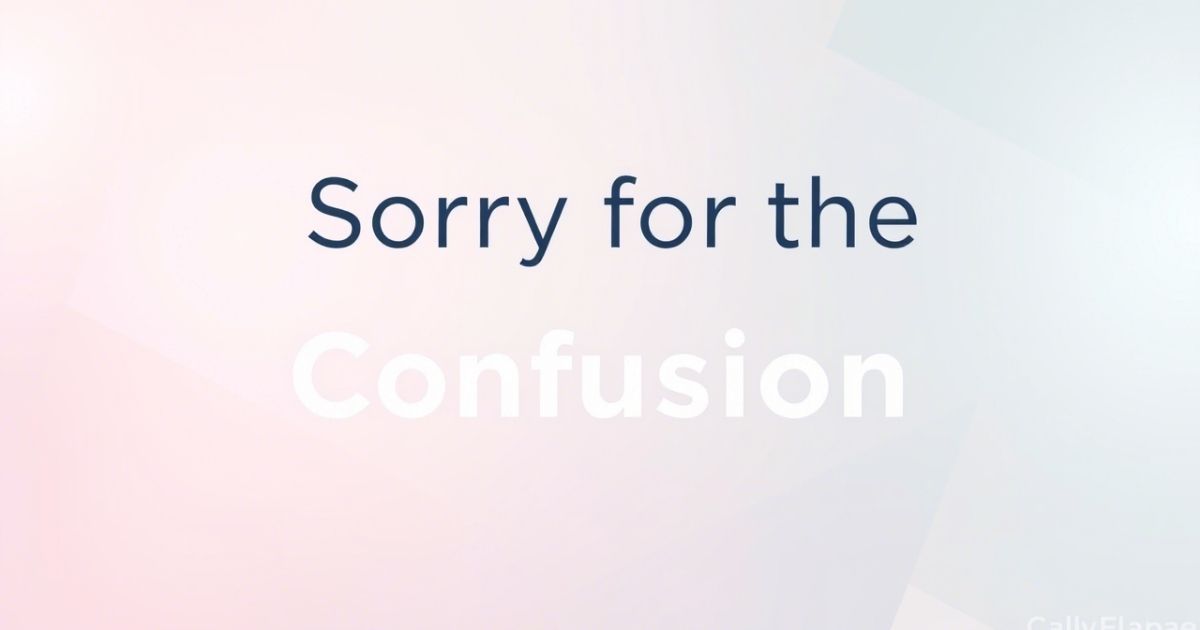Sorry for the Confusion we’ve all said it. Whether it’s a mix-up at work or a misheard message, confusion happens. And when it does, a simple, clear apology goes a long way. Saying Sorry for the Confusion shows you care and want to make things right. It helps keep things calm and respectful.
There are many ways to say Sorry for the Confusion. You might say apologies for the confusion, apologize for the confusion, or try a sorry for the confusion synonym. Need another way to say sorry for the confusion? Try “pardon the mix-up” or “excuse the misunderstanding.” However you say it, the goal is the same show respect, admit the mix-up, and move forward. Clear words fix unclear moments. So, next time things get messy, don’t hesitate. Just say Sorry for the Confusion and help smooth things out.
Main Points
- Sincere apologies build trust – Owning a mistake with phrases like my sincere apologies or apologies for the confusion shows accountability and respect.
- Misunderstandings are common – Use phrases like regret the misunderstanding or apologies for the mix-up to clear the air and maintain harmony.
- Admitting fault strengthens communication – Saying my mistake or pardon the error promotes honest dialogue and shows maturity.
- Clarify to prevent further confusion – Use let me clarify or clarification needed to ensure everyone’s on the same page.
- Politeness matters in professional settings – Phrases like apologies for the discrepancy and apologies for the oversight show professionalism.
- Be proactive, not defensive – Address issues early with phrases like acknowledge the confusion or please excuse the confusion.
- Avoid placing blame – Focus on solutions and understanding rather than who was wrong, to promote a harmonious atmosphere.
- Miscommunication should be addressed – Don’t ignore it. Say apologies for any misconception or for the misinterpretation to correct errors kindly.
- Effective communication requires effort – Use clear, simple language and acknowledge confusion when it happens to keep things moving smoothly.
- Apologies promote mutual understanding – They help clear communication barriers and foster respect in both personal and professional relationships.
Apologies for the Misunderstanding
Apologies for the misunderstanding often come after two people see things differently. It helps calm the situation and open the door for better communication. A misunderstanding doesn’t mean someone meant harm—it usually means something wasn’t said clearly or got taken the wrong way.
Saying apologies for the misunderstanding shows you’re willing to fix it. This phrase helps you take responsibility and move forward without blame. It also shows respect for the other person’s view and encourages honest conversation.
My Mistake
Saying my mistake is a simple, human way to own up when you’ve done something wrong. It shows humility and accountability without making excuses. People appreciate it when you’re honest about slipping up.
Admitting my mistake quickly helps avoid bigger problems. It builds trust and shows you’re not afraid to correct yourself. That kind of attitude creates a more respectful and understanding environment.
Accept My Apologies

When you say accept my apologies, you’re asking someone to forgive you sincerely. It’s a polite, thoughtful way to mend a small or big issue. You’re not just saying sorry you’re trying to restore peace.
Using accept my apologies shows maturity and a clear effort to fix things. It helps rebuild connections and shows the other person that you truly regret the situation and care enough to make it right.
Clarification Needed
Sometimes, messages don’t come through clearly. When that happens, saying clarification needed can stop confusion from growing. It’s a respectful way to ask for more details without sounding rude.
Using clarification needed also shows you’re listening and trying to understand better. It helps promote effective communication and avoids future mix-ups, especially in professional conversations or important discussions.
Apologies for the Mix-Up
Everyone makes mistakes. When plans go wrong or details get crossed, saying apologies for the mix-up keeps things calm. It helps clear up errors without placing blame.
Using apologies for the mix-up is a polite way to admit something didn’t go as planned. It also shows you’re ready to fix the situation and move forward with a clear understanding.
Let Me Clarify
When things get messy, saying let me clarify helps clear the fog. It gives you a chance to restate your message more clearly. This avoids further misunderstanding.
Let me clarify is useful in both casual talks and professional settings. It shows you’re focused on making sure everyone is on the same page. That’s key for good communication.
Related Guide:
15 Other Ways to Say “No Worries”
Pardon the Error
Mistakes happen. When they do, saying pardon the error is a gentle way to ask for understanding. It admits the fault without making things worse.
Using pardon the error also shows professionalism. It’s often used in business or formal emails when you want to show you’re taking responsibility and staying polite.
For the Misinterpretation
Sometimes people hear one thing but think it means another. When that happens, saying for the misinterpretation, you’re admitting something wasn’t clear. It’s a smart way to smooth things over.
For the misinterpretation also signals that you value mutual understanding. You’re not blaming anyone—you’re just acknowledging the confusion and trying to straighten things out together.
Regret the Misunderstanding
Sometimes, no matter how carefully we speak or act, misunderstandings still happen. When they do, it’s important to express that we regret the misunderstanding. This simple phrase shows you’re not brushing the situation aside. Instead, you’re showing that you care about how the other person feels and want to set things straight.
Using regret the misunderstanding also keeps things calm. It shifts the focus from who’s at fault to how you can fix the issue together. Whether it’s a mix-up in communication or a missed cue, expressing regret opens the door to respectful and effective conversation. It’s a mature, thoughtful way to move forward with better understanding.
Acknowledge the Confusion
Sometimes, things just aren’t clear—emails get misread, instructions get misunderstood, or messages don’t come across right. When that happens, it helps to acknowledge the confusion right away. Ignoring it only makes things worse. By facing it directly, you’re showing the other person that their feelings and perspective matter.
Saying you acknowledge the confusion builds trust. It tells people you’re open to fixing the problem, not avoiding it. In personal or professional conversations, this kind of honesty leads to stronger, more respectful communication. It sets a positive tone and helps prevent the same confusion from happening again.
Apologies for the Discrepancy
When details don’t line up—like numbers, timelines, or facts—it’s best to say apologies for the discrepancy. This phrase shows you’re not ignoring the issue or trying to cover it up. Instead, you’re admitting there’s a difference and you’re ready to take action.
Whether in reports, emails, or conversations, saying apologies for the discrepancy reflects professionalism and honesty. It also shows accountability, which people respect. Mistakes are easier to forgive when you’re upfront and ready to correct the error. This approach keeps working relationships strong and communication transparent.
Apologies for Any Misconception
We don’t always realize when our words are unclear or give the wrong impression. If that happens, it’s thoughtful to say apologies for any misconception. This phrase clears the air and shows you’re aware of how your message may have been misunderstood.
Using apologies for any misconception helps resolve tension quickly. It shows you’re not defensive or dismissive—you’re trying to understand and be understood. That kind of attitude helps create open dialogue and better communication moving forward. It’s a simple way to take responsibility without assigning blame.
Please Excuse the Confusion
When something you said or did causes confusion, it’s kind to say please excuse the confusion. This polite phrase acknowledges the mix-up while gently asking for patience and understanding. It helps prevent frustration and keeps conversations respectful.
Saying please excuse the confusion works in both casual and professional settings. It lets people know you’re aware of the mistake and that you’re ready to clear things up. This small act of honesty shows that you care about keeping things smooth, respectful, and well understood.
Apologies for the Oversight

Even the most careful people miss things sometimes. When you do, saying apologies for the oversight shows humility and professionalism. It’s better to admit the error than to let it slide or hope no one notices. Owning the mistake builds more respect than trying to hide it.
Using apologies for the oversight also signals you’re committed to improving. It lets others know you’re paying attention and willing to correct the error. In work settings, this phrase maintains trust and keeps projects moving forward smoothly. Everyone makes mistakes owning them is what sets you apart.
My Sincere Apologies
When an error causes real inconvenience or hurt, saying my sincere apologies can help make things right. This phrase goes beyond a quick “sorry.” It shows true regret and that you deeply care about how your actions affected the other person.
Saying my sincere apologies creates space for healing. It shows you’re not just saying the words, you mean them. It’s often used in heartfelt apologies, whether in personal situations or serious professional errors. When spoken with honesty and a willingness to fix things, this phrase can go a long way toward rebuilding trust and moving forward.
FAQ’s
What does Sorry for the Confusion mean?
It means you’re admitting a mistake or mix-up happened. You’re trying to clear things up and keep things peaceful.
When should I say Sorry for the Confusion?
Say it when someone misunderstands you, or if you gave unclear information. It helps fix the moment and shows respect.
Is Sorry for the Confusion a real apology?
Yes, it is. It admits something went wrong and that you’re taking responsibility for clearing it up politely and quickly.
What are alternatives to Sorry for the Confusion?
You can say apologize for the confusion, apologies for confusion, or use a sorry for the confusion synonym like pardon the mix-up.
Is Sorry for the Confusion professional to use?
Yes, it’s polite and often used in emails. It keeps communication smooth and shows you’re willing to fix any misunderstanding.
Conclusion
Sorry for the Confusion is a simple but powerful phrase. It helps clear up mistakes and smooth over any miscommunication. Saying Sorry for the Confusion shows you’re honest and care about fixing things. It’s a kind way to admit something went wrong. People respect that. When you use this phrase, you take responsibility and show respect.
There are many ways to say it. Try apologies for the confusion, apologize for the confusion, or use a sorry for the confusion synonym if you want to change it up. You could also say apologies for confusion in a short message. If you’re not sure what to say, just be clear and kind. Use whatever words help the other person understand. The goal is to move forward and build better communication. In any case, saying Sorry for the Confusion keeps things calm and helps fix misunderstandings fast. That’s always a smart choice.

Ember Rose is a dedicated administrator with 4 years of experience in efficient operations management and team leadership. Skilled in streamlining workflows and enhancing productivity.

